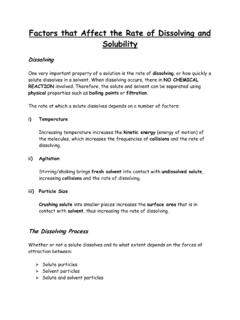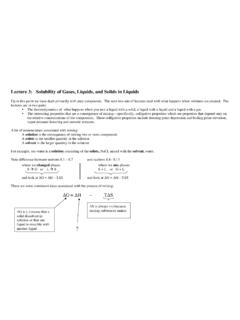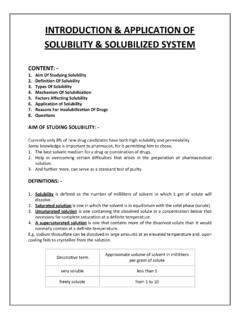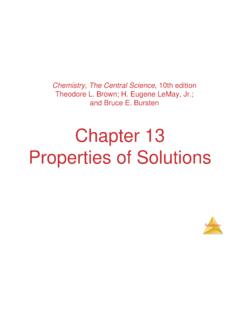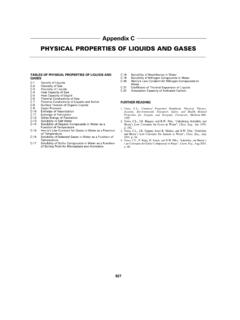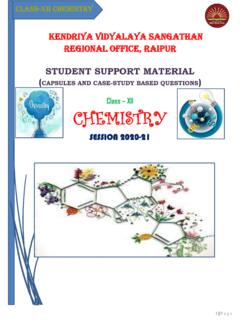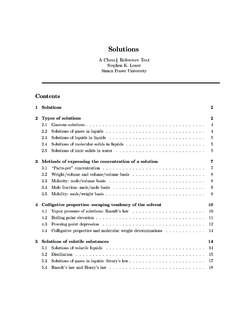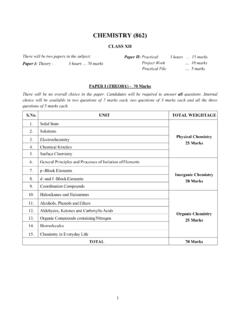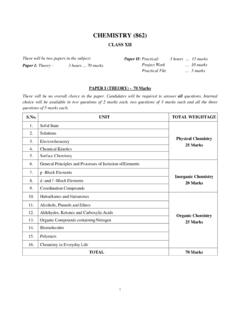Transcription of IGCSE
1 IGCSE Complete Chemistry Notes According to Syllabus Source: | Special thanks to ThatReallyReallyWeirdDude IGCSE Chemistry Textbook IGCSE Chemistry Syllabus Compilation by : WooWooWoo 2 Compiled by WooWooWoo Chapter 1: The Particulate nature of matter Matter is anything that has mass and occupies space. There are 3 states of matter, solids, liquids and gases. Solids: The particles are packed closely together. The forces between particles are strong enough so that the particles cannot move freely but can only vibrate. As a result, a solid has a stable, definite shape, and a definite volume. Solids can only change their shape by force, as when broken or cut. In crystalline solids, the particles (atoms, molecules, or ions) are packed in a regularly ordered, repeating pattern.
2 There are many different crystal structures, and the same substance can have more than one structure (or solid phase). Solids can be transformed into liquids by melting, and liquids can be transformed into solids by freezing. Solids can also change directly into gases through the process of sublimation. Liquids: A liquid is a nearly incompressible fluid which is able to conform to the shape of its container but retains a (nearly) constant volume independent of pressure. The volume is definite if the temperature and pressure are constant. When a solid is heated above its melting point, it becomes liquid . This means that the shape of a liquid is not definite but is determined by its container, the most well known exception being water, H2O. Gases: A gas is a compressible fluid.
3 Not only will a gas conform to the shape of its container but it will also expand to fill the container. In a gas, the molecules have enough kinetic energy so that the effect of forces is small, and the typical distance between neighboring molecules is much greater than the molecular size. A gas has no definite shape or volume, but occupies the entire container in which it is confined. A liquid may be converted to a gas by heating to the boiling point. The Kinetic Theory of Matter States: The kinetic theory is a theory put together by the finest chemists and physicians of all time. It consists of a number of true facts related to matter and their states. The theory explains the behavior of matter and their physical properties. The kinetic theory of matter states: All matter is made up of tiny, microscopic moving particles.
4 And each matter has a different type of particles with different size and mass. 3 Compiled by WooWooWoo Particles are in continuous movement. All particles are moving all the time in random directions (Brownian motion). The speed of movement depends on the mass of the particle, temperature and several other factors that you will know later on. Kinetic means movement, and so kinetic energy means movement energy. Comparing Properties of Solids, Liquids and Gases: Molecular Structure solid liquid Gas Particles Arrangement Very closely packed Regularly arranged in lattice Closely packed Irregular arrangement Very far apart Very irregular arrangement Intermolecular Spaces Almost none Negligible Minimal Tiny spaces Very large Intermolecular Forces Extremely strong Not weak Weaker than in solids Very weak Movement of Particles Vibrating in a fixed position Slowly slide over each other randomly Fast movement in random direction Shape Fixed definite shape No fixed shape Depends on the container No fixed shape Volume fixed fixed No fixed volume Depends on the container Compressibility Cannot be compressed Can be hardly compressed Very compressible Diffusion Cannot diffuse Diffuses slowly Diffuses quickly Physical Changes
5 (Change in State): Physical changes are changes in which no new substance is formed. For example melting and ice cube or dissolving salt in water. Physical changes are reversible. For instance if you heat and melt and ice cube to water, you can put it in a freezer and have it changed back to ice. Changing the state of a matter is a physical change. And it is done by either heating or cooling. The following diagram represents changes in state: 4 Compiled by WooWooWoo Melting: The change of state from solid to liquid . The temperature at which a solid melts is called the melting point. Evaporation: The change of state from liquid to gas. The temperature at which a liquid evaporates is called the boiling point. Some substances never exist in a liquid form. If they are solid and you heat them they turn into a gas, and if they are a gas and you cool them they turn into a solid .
6 This process is called Sublimation. The change in state occurs when the temperature is raised or dropped. Melting occurs when you heat a solid because heating gives the particles more kinetic energy making them move faster and further apart, making the solid expand. Until at some point they have enough energy to break the forces of attraction between them and the lattice turning into liquid . If you keep heating the liquid , particles will gain even more kinetic energy and start moving even faster, pushing each other away. The particles at the surface have the highest amount of energy that they can break the forces of attraction and escape as a gas; this is the start of evaporation. At some point, particles will try to escape so quickly that they form bubbles of gas in the liquid .
7 This is the boiling point at which the pressure of the gas forming above the liquid is the same as atmospheric pressure. On the other hand, cooling a gas will make its particles lose their kinetic energy and move closer and slower. Eventually the forces of attraction will hold them together forming a liquid (condensation). And if a liquid is cooled, its particles will move closer and slower until the forces of attraction are strong enough to hold them tight together forming a solid (freezing). During the actual change of the state, the temperature of the matter is constant because any heat energy supplied is used to break the bonds. So if you record the temperature change during heating a solid , the temperature will first rise, then it will remain constant for a while (this is the melting point) and then it will rise again.
8 The following figure is a heating curve of a solid . At point A the state is solid . At point B the solid is melting; it is a mixture of solid and liquid . At point C the state is liquid . At point D the liquid is evaporating, it is a mixture of liquid and gas. At point E the state is gas. Temperature X is the melting point while temperature Y is the boiling point. 5 Compiled by WooWooWoo The following figure is a cooling curve of a gas. At point A the state is gas. At point B the gas is condensing; the state is a mixture of gas and liquid . At point C the state is liquid . At point D the liquid is freezing, the state is a mixture of liquid and solid .
9 At point E the state is solid . Temperature X is the melting point and temperature Y is the boiling point. Some liquids evaporate extremely quickly at room temperature, they are said to be volatile liquids. The purity of substances can be easily determined by testing its boiling and melting points. This is because pure substances have sharp boiling and melting points, while those of impure substances are ranging. Diffusion: Diffusion is the random movement of liquid or gas particles to fill the available space and spread evenly. For instance, if you pass by a trash can, you can smell the ugly scent of trash. This is because molecules from the garbage diffused out of the can to the air which you breathed in. Diffusion rate depends on several factors, these are: Mass of the substance.
10 The lighter the substance (lower Mr or Ar) the faster it diffuses Temperature. The more kinetic energy the particles have, the faster they move and diffuse. 6 Compiled by WooWooWoo Presence of other substance. Diffusion is faster when it occurs in an area where there are fewer particles of other substances present. This is why diffusion is extremely fast in vacuums. This is because the diffusing particles have less other particles to stand in their way. Intermolecular spaces. This is why gases diffuse faster than liquids and solids do not diffuse. Diffusion of gases can be proved very easily. We can prove it by putting some bromine liquid in a cylinder and sealing it, then putting another inverted cylinder above it. When the bromine liquid evaporates, we remove the lid between the two cylinders, the brown bromine gas will diffuse upwards filling the available space.

